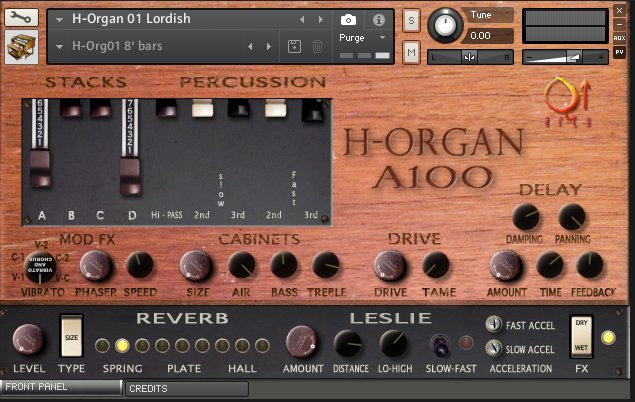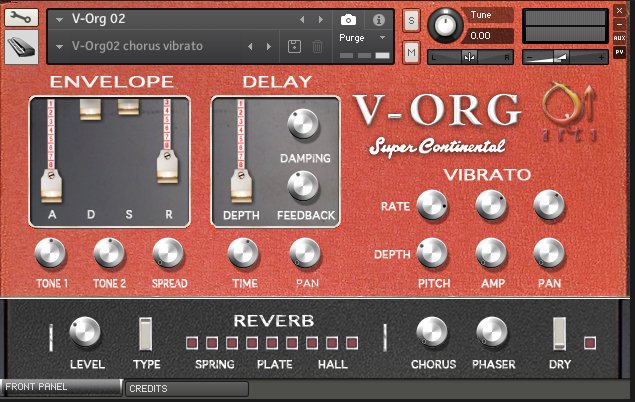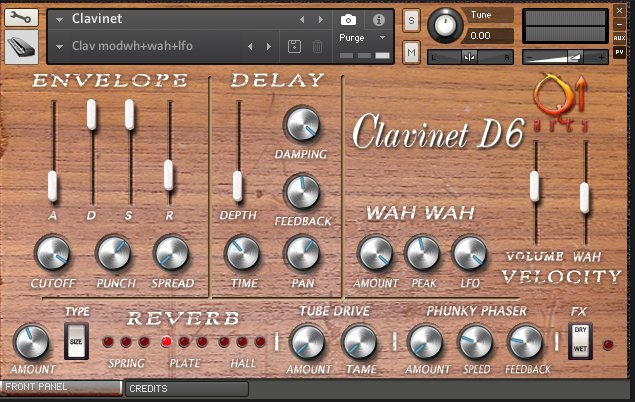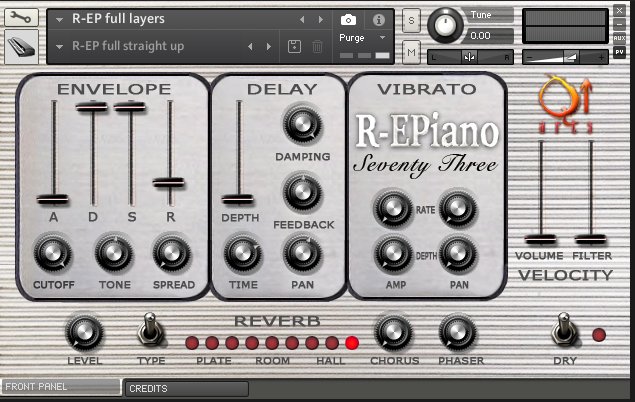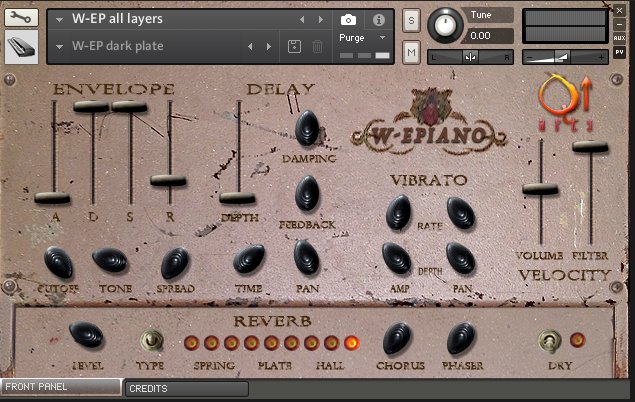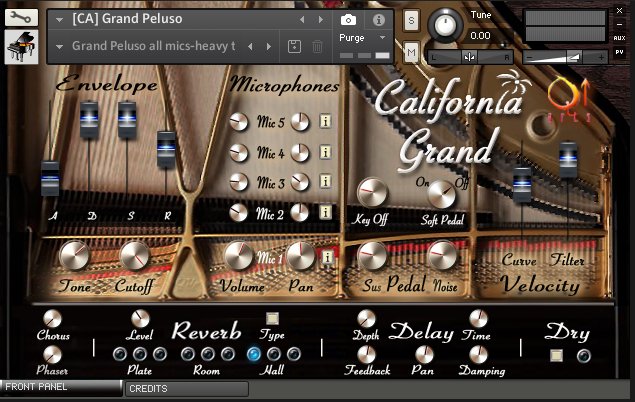Unlike most Farfisa VIs, there is absolutely no way to select/deselect the various instrument registrations. There are only two main patches included in this sample set, and both are quite bright and treble-y. Be that as it may, the “F-Organ 2” patch is the more even-keeled, better sounding of the two. Since I like playing organ and synth VIs with a semi-weighted 61 key controller, I found it necessary to transpose my keyboard down an octave. This allowed me to access the lower registers and warmer tones available in this sample set. Things improved considerably after I’d recruited a cabinet IR (impulse response) . With a snap-simple Kontakt tweak, the F-Organ took on a whole new, glorious sonic character – one that was vibe-y and highly palpable. The tone became even-balanced and sumptuous. Distinctly retro and ever authentic Farfisa Compact sounds leapt out of my speakers on demand.
In keeping with all things Vox, I added NI’s Brit 60s 2x12 Cabinet IR; which to my understanding was captured from a Vox AC30 loaded with a pair of Celstion Alnico Blue 12” speakers. After making this little tweak, the resultant sound was a very nice improvement. What started out as a raw, slightly brittle tone was splendidly transformed into a full, robust resonance. Soaring highs were still intact, but the delicate rounding that 12” guitar speakers impart to a splintery line-level signal ushered V-Organ to a whole new sonic plane.
As a general statement, I consider this sample-set to be a very well-balanced blend of lush Rhodian timbre, release noises, and tine-ness. (I just made that word up, I hope you like it.) Yes, R-EPiano has a few antique weaknesses on some notes between C5 to C6, but mayhap that quantifies this one to be verifiably realistic and authentic sounding. That said, would it have been slightly misleading if Q Up Arts had replaced the less-than-ideal tones with programmatically enhanced samples? I honestly can’t answer that question – the raw authenticity is laudable, but so too is pristine sound. You decide, dear reader. Smile.
Ever the ol’ skool traditionalist that I am, I’ve prepared a couple of audio snippets featuring the delectable, pure tone of this Wurlie. The first segment is a plaintive soul vibe with only a tasteful mix of tremolo. The second clip hits the higher register more and shows off lush spring reverb and a subtle undergirding of delay. CA-Grand – We now survey the final exhibit on our California Keys tour; the magnificent 10 ft’ Fazioli Grand. There were 10 channels of microphones par excellence used to capture this magnificent specimen – these include enviable capsules from Earthworks, Peluso, and Audix. Furthermore, the microphonic transductance was aptly channeled into a Pro Tools HD system through Class-A preamps from Neve, Universal Audio and Grace. While most of the mic channels are stereo pairs, there was a monophonic Neuman U87 used to record the piano from underneath; just left of center. To ensure that we could participate in a gratifying, comprehensive Fazioli Grand experience, Q Up Arts fastidiously sampled 30 layers of natural velocities – plus an undetermined number of round robin samples!
Timbre preferences aside, the sonority of this instrument is exquisite! The sampling quality is sublime and need not take a back seat to other libraries of like kind. There are other equally-as-large, highly detailed offerings on the market now-a-days; Wavesfactory’s “Mercury”, Bechstein-Digital’s “C-Bechstein”, SonicCouture’s “Hammersmith” are a few that come to mind. That’s elite, high class social circles to appease folks. Does Q Up Arts’ CA-Grand belong in such illustrious company? On the basis of visual appeal, I would say that it comes a little under-dressed; but sonically it stands up every whit as well. Across the complete key-range of this piano, the tonality is well-balanced and articulate. There’s an aliveness about the sound, and a responsiveness to touch, that must be experienced to be properly understood. To say that the instrument is dynamic is an understatement. The low register of this piano can thunder for sure, but it always remains clear and articulate. The mids are graceful and majestic; these too remain defined and pure throughout all velocity layers. An airy, pellucid high region is evident; howbeit it never becomes brittle or sterile sounding. As trite and clichéd as the word has unfortunately become in today’s music vernacular, “organic” is most certainly an apt adjective to describe the sound of this sample set. Other factors contributing to the veritable nature of CA-Grand are seamless fusion of the library’s release samples and sympathetic resonance. If these weren't enough, realism is further actualized with some nifty, dedicated soft-pedal samples to convincingly simulate a grand piano’s soft pedaling functionality. My ears tend to favour the “Grand Peluso” NKI due to its somewhat livelier upper midrange presence. Regardless of which patch or snapshot you choose, luxurious tonality, and vast dynamic verismo are immediately at your fingertips.
I'll be the first to admit that I'm not a great pianist; I just enjoy faking it. *Grin. Here are a couple of clips for you to hear CA-Grand for yourself. The first is a moody, softer Jazz-ish piece. I used the "Grand Peluso" for this clip, with the tone knob dialed up to about 2:00 o' clock. The second clip is a bouncy, R&B/Pop take -- it compares the "Grand Peluso" configuration to the "Grand Earthworks". Both patches were adjusted to use the same type of mic settings, and the tone knob was set at 2:00 o' clock. CPU & Memory Consumption: Taking into account that each of the e-pianos and transitors organs are monophonic sample-sets, their memory footprints are very small. The H-Organ is not negligible, consuming a noticeable 1.2 GB of memory. All of these samples load up in good time from a 7200 rpm HDD. As already stated, the Fazioli Grand sample-set is huge, gulping down 2.14 GB of memory at the least. I realize that not everyone has a dedicated SSD drive(s) in their system for the sole purpose of storing sample libraries, but if you want to have a fluid experience and speedy load times, you might want to consider getting an SSD for the CA-Grand and similar sample libraries. As regards CPU drain, Kontakt’s (v5.81 standalone) CPU meter seems to hover around the 3% mark with occasional peaks as high as 15 - 20% when liberal amounts of FX are applied. These conservative observations are ascertained while using the e-Pianos and organs. The CA-Grand, on the other hand, can easily utilize upwards of 30% CPU with the larger patches, and I've seen busy arrangements and generous FX make it spike up to 75 - 80 percent. Yikes! If I scale back the number of mics or use lighter patches, this drops to half or less. As a reference point, my system is powered by a 2016, i7 7700 HQ chip. Concluding Remarks: I’m pleased to report that there is a lot that I dig about this bouncing bounty of vintage vibe-a-licious-ness. I have a few quibbles with the collection, but overall I’m not shy to recommend Cali Keys as a solid, usable choice for anyone looking for a well-rounded collection of classic keyboards and organs. I’m not sure that I can recommend the Fazioli Grand sample-set as a “desert island”, one-size-fits-all piano choice; however, that greatly depends on the style(s) of music you play. Even with 3rd party, external processing, CA-Grand really doesn’t have an in-your-face, pop/rock character; at least not in the way that a top drawer Yamaha C7 (or similar) exudes. Still, it’s an exquisite grand piano sampling; one that possesses a refined, complex individuality that no other sampled piano compares to – at least none that I’m personally familiar with. I can say without hesitation that there is bona fide, raw genuinity inherent in each one of the sample-sets contained in the California Keys library. There are many sample libraries and modelled VIs on the digital playground that produce smoothly polished sounds; notwithstanding, few of them are comprised of totally original and unaltered samples. Neighboring notes are borrowed to fix wonky ones, and undisclosed studio tweaks n’ tricks are sometimes quietly slipped in to suppress audible disparities. Our ears, and thus our mindsets, have come to expect unrealistic perfection from virtual instruments. The truth of the matter is, well-maintained classic instruments possess timeless charm and distinctiveness; due in part to their electro-mechanical warts and all. In the case of Cali Keys, I don’t suspect that there were many (if any) post-sampling “fixes” applied to the original samples. What Arlan Schierbaum hears when he plays his vintage keyboards is exactly what was sampled – pure and original.
Stay in the Loop - Subscribe Today!Brother Charles is a freelance writer, Gospel music artist and minister. Charles had been a professional touring musician during the nineties; working primarily as a lead guitarist in the Canadian country music industry. Brother Charles is also involved with music production and quality home recording.
1 Comment
|
Subscribe to the Reviewer's Revival NewsFlash for notifications of the latest REVIEWS, SALES and exclusive COUPON-CODES. CLICK HERE |

